-
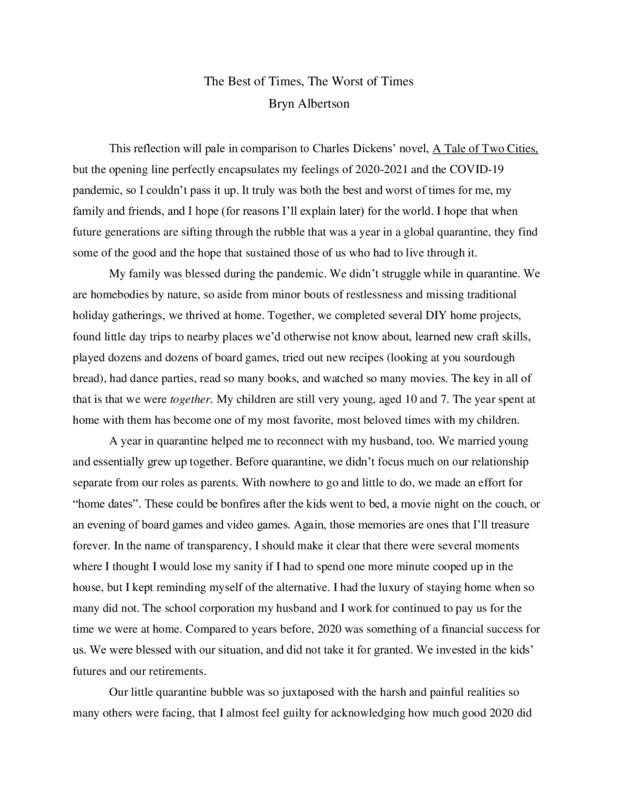
2021-04-22
I am submitting this for my Rel 101: Religion, Culture, and Public Life course.
-

2021-04-19
After 400 days to the day, my daughter walked back into her gym. A competitive gymnast who has been training with the same gym since the week before she turned 3, this has been a long year. We are privileged in the sense that the hardest decision we had to make during the pandemic was not related to jobs security, hunger, or even health (beyond keeping ourselves from COVID). Our hardest choice was not allowing our daughter to return to her gym to train when they reopened in June. My husband and I knew COVID was just beginning. We knew the spike would come and the health of our family wasn’t something we were willing to risk, especially because our jobs allowed us the luxury to work from home and distance. At first, we made case rates dropping our marker of when she’d go back. Then, with the announcement of the vaccine, we decided to wait until our household was vaccinated. By the end of March, the adults of our household were vaccinated and our local case count had dropped considerably, to an infection rate percentage of 1.4%. Still, we wondered “should we just wait until she’s vaccinated?” But she’s 10, there is no vaccine being publicized for her age. How long can we keep her from her life? It’s not just the training. It’s about mental health. We’ve kept her physically safe, but she’s 10 years old and hasn’t seen a single friend in person for almost 14 months. She hasn’t shown any signs of a mental health crisis, but even if she isn’t showing anything, this has to have taken a toll on her. It was a difficult and scary choice, but my husband and I decided her mental health and emotional health are worth the risk. She is so happy. She’s had two one on one sessions with her coach and we are all shocked (and relieved) that her daily solo workouts EVERY SINGLE DAY for 400+ days now paid off. She not only kept all her skills but learned enough her skills to advance to the next level. I know her coach is shocked. I don’t think she really believed that a kid would work hard enough on her own to keep in shape. I know my daughter is very proud and very relieved to know she can compete again. And the timing is perfect - the new season starts in May, so she’ll begin in a new level with other girls she knows who also leveled up. She never acted unhappy during quarantine, but since going back, she’s seemed lighter and happier. Still, the two times she went were one on one. The beginning of May will see her going back full time, three practices a week for ten hours a week of practice. I’m happy they’re letting her keep her mask on and that the coaches are wearing masks but I’m still nervous. It’s so hard to send your kid into a situation that may lead them to contract a deadly illness. But it’s also so hard to keep your kid in a bubble. I never in a million years imagined I’d have kept my child home for 400 days. I’m a public school teacher, I’m the first person to tell you the importance of socialization. But in a pandemic, I guess my mothering deep instinct to my child overpowered anything else. I hope and pray with everything in me that we don’t regret allowing her to go back. I hope we are turning a corner in CA and that a vaccine for kids arrives soon so I can feel slightly more relaxed.
-
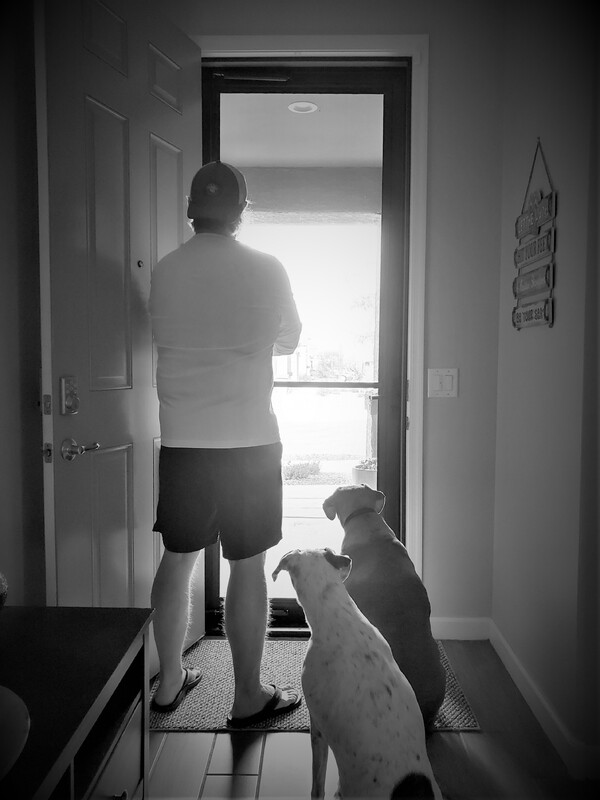
2021-04-21
--Reflections on the Pandemic Archive--
Looking back over my experience with the “Journal of the Plague Year” COVID-19 archive, my prevailing emotion is gratitude. This opportunity granted me experience that few historians earn, and the remote, asynchronous work schedule allowed me to collaborate with my colleagues in ways that maximized our respective contributions. The breadth and depth of our individual experiences and perspectives tremendously improved our collective process and products.
I spent enough time in the Arizona State Archives last year to recognize such collections as historical treasure chests, but I have now participated in processing an archive’s content and navigating the ethical dilemmas those submissions sometimes create. Archivists and curators are the history profession’s truly unsung heroes, and their work facilitates society’s perception of itself.
My background in police work and public safety drew me to the archive’s existing Law Enforcement collection. In taking on that subset, I succeeded in reshaping the collection’s parameters to now include stories about police and law enforcement. I wanted to diversify the collection to encompass perspective of both the police and the public with whom they interact and serve. While some overlap exists between the Law Enforcement and Social Justice collections, each remains distinct. Through my contacts and writing, I promoted a Call for Submissions to an international audience of law enforcement professionals to reduce their relative silence within the archive.
Within the archive’s content, I recognized that one’s location might shape their pandemic experience, and I created and designed an Arizona-based exhibit to explore that. Further research and discussion with my mentors and colleagues ensured the exhibit illustrated these differences without excluding visitors whose diverse experiences could further enrich the archived and exhibited content. I am proud of my “Arizona’s COVID-19 Pandemics” exhibit, particularly because of its compressed, one-month incubation period. Beyond displaying images, data, and stories representative of the diverse pandemic experiences within the state, the ACP exhibit offers visitors numerous levels of interaction and engagement to became active participants and create their own exhibit experience. Visitors can complete opinion surveys, add a story to the archive, explore additional content related to the displayed pieces, view ever-changing results from pre-defined archival content searches, conduct their own archival search, view collective visitor survey results, and apply to join the staff. The exhibit’s searches will include the archive’s future submissions, which reshapes both the exhibit and the experience visitors may have with it.
A more detailed explanation of my ACP exhibit may be reviewed here: https://covid-19archive.org/s/archive/item/43037
Because of Dr. Kathleen Kole de Peralta and Dr. Mark Tebeau, I stand prepared to join research, curation, and exhibition teams and immediately contribute to their work products.
Despite my gratitude for this experience and the opportunities it presented, I look forward to the day COVID-19 is no longer part of humanity’s daily vernacular.
James Rayroux
22 April 2021
-
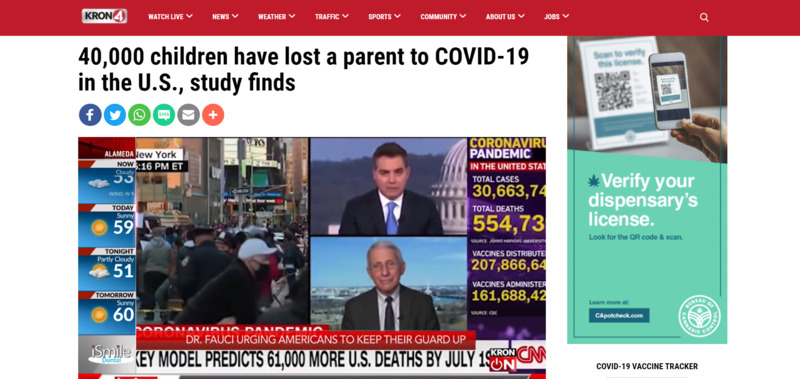
2021-04-05
(NEXSTAR) – In a grim reminder of the death toll from COVID-19, a new study published by the American Medical Association found that nearly 40,000 U.S. children have lost one of their parents to the virus.
It’s a heartbreaking new angle to the number of U.S. deaths since the pandemic began – 555,273 as of Monday afternoon, according to Johns Hopkins University.
“This may come as a surprise, since 81% of lives lost in the US have been adults 65+,” study author Rachel Margolis, an associate professor at the University of Western Ontario, tweeted. “However, we are also seeing high mortality among younger adults, many of whom have children under 18.”
-
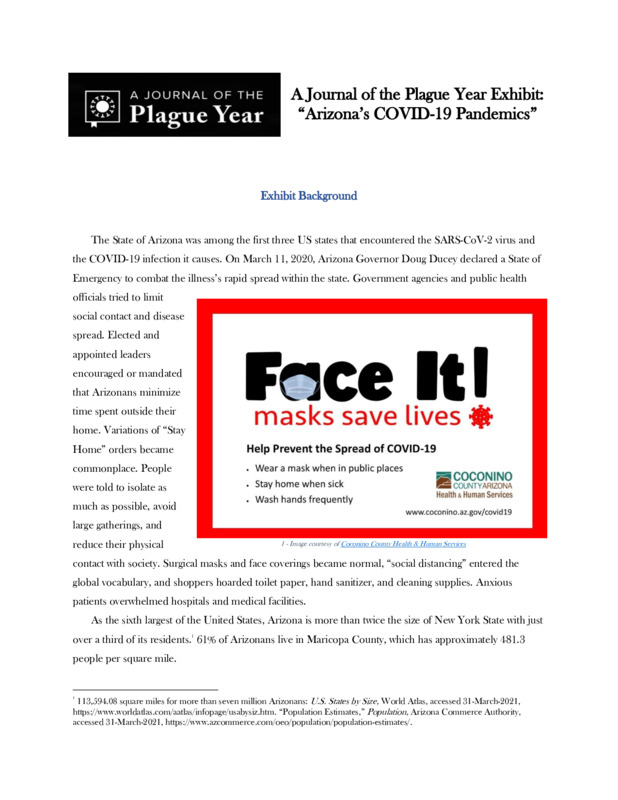
2021-04-20
While working as a curatorial intern on ASU's 'A Journal of the Plague Year' COVID-19 archive, I created this exhibit on the pandemic experience within the state.
In addition to obvious, overarching realities such as socioeconomic status and immediate access to healthcare systems, I initially believed one of the greatest deciding factors that determined one's experience in Arizona was an individual's residence in either predominantly urban or rural environments. The proposed exhibit had been originally titled "A Tale of Two Arizonas" to pay respect to Charles Dickens and the differing realities experienced here.
To test my proposed hypothesis, I went about finding data, stories, and submissions that substantiated or disputed my premise. Within a short time, I had identified four distinct environmental drivers of personal pandemic experiences; to me, that indicated the existence of many more I hadn't yet found or had overlooked along the way. My evidence suggested a minimum of four pandemic locales: Urban, Rural, Border, and Tribal within the State of Arizona and its fifteen counties. The recorded health data and personal experiences demonstrated the naivete of my initial hypothesis, and I retitled the exhibit: "Arizona's COVID-19 Pandemics."
The Exhibit Background section illustrates the vast dichotomies within Arizona in terms of population density and access to healthcare facilities. Given the virus's respiratory nature, these factors seemed especially relevant to driving diverse local experiences. I chose to include a flyer from the Coconino County Health and Human Services' "Face It! Masks Save Lives" campaign. The flyer included a specific line to "Stay Home When Sick" that seemed to illustrate a different public health paradigm than the broader "stay home" orders from Maricopa and Pima county. This section also features an image of Sedona's red rocks and a portion of The Wave to remind visitors of the wide-open rural areas accessible to all, as well as those with cultural significance to the Native American tribes and limited access to the general public.
The next section asks a short, five-question survey in which visitors may participate.
The Silver Linings piece features a short audio clip of a father and husband discussing some unexpected benefits of the pandemic. Visitors may explore additional Silver Linings stories and submit their own experience.
The Tséhootsooí Medical Center piece seeks to illustrate the different pandemic experience on the state's tribal lands. I hoped to inspire some relevant emotional turmoil for the visitors through the piece's visual presentation. I wanted to create a series of waves with quotes from the medical center's healthcare workers. I hoped visitors' attention would be drawn to the large, bolded key words, and that they would first experience the segments out of sequence because of that. After potentially feeling a sense of chaos, they might settle themselves into a deliberate reading of the texts and find their own order within the experiences provided here. This piece allows further exploration of Native submissions and topics, a review of an additional related news article, and a submission prompt that invites visitors to offer guidance to hospital managers.
The next piece illustrates the differences between mask mandates in communities across Arizona. In addition to hearing an audio clip of interviews with mayors and a public health official, visitors can explore additional submissions related to mask mandates and submit their thoughts on statewide mandates.
The Arizona Department of Health Services provides zip-code specific infection data on its website, and the wide array of known case infections therein further illustrates potential dichotomies across the state. In working to include and represent this data in a consumable way, I encountered inconsistencies with tribal data. The nation's Indian tribes are overseen by Indian Health Services, a federal public health agency, and it does not collect or report data in the same manner as the State of Arizona or its counties. At first glance, the data would seem to suggest that tribal areas had less severe pandemic experiences than the rural and urban areas, which was not objectively true. I wanted to offer the unedited data to visitors, allow them to drawn their own conclusions, and invite them to offer their thoughts on what potential misunderstandings might emanate from these reporting differences. Visitors may also choose to review the foundational data from this piece, as well.
I used the following two sections to offer submission prompts about the visitor's overall pandemic experience as a function of their location, as well as what they might have done if placed in charge of their city, county, or state during this pandemic.
A diverse Search section allows visitors to explore additional topics of interest to them. 23 hyperlinks offer pre-defined search parameters. An Advanced Search link allows self-defined research, and a Join The Staff link connects visitors with opportunities to work within the JOTPY archive.
A final section asks visitors to provide feedback on the exhibit, its content, and the pandemic in general.
Both surveys within the exhibit will display overall results to visitors who participate in them.
Through this process, I found incredible amounts and diversity of data outside the archive that spoke to these generally localized experiences, but not that much yet within the archive explained what Arizonans had experienced outside the state's urban environments. I created a call for submissions and delivered it to fifty rural entities that might help support the effort to collect and preserve more rural Arizona stories. Between all the local libraries, historical societies, museums, small-town mayors, and county health officials to whom I asked for help, I am optimistic the archive will better represent all Arizonans in the coming months and years. Despite the exhibit having been created, I ensured its internal search features would include future submissions and allow the exhibit to remain relevant long after its release.
-

2021-04-20
During March and April 2021, I created an online exhibit from content within Arizona State University's "A Journal of the Plague Year" COVID-19 archive. Entitled "Arizona's COVID-19 Pandemics," the digital exhibit contained images previously submitted to the archive, along with several copyright-free images I found on pexels.com. I have attached all these images. Listed by their order of appearance within the exhibit, their sources are as follows:
1- "Face It" Campaign flyer: Coconino County Health & Human Services ( https://covid-19archive.org/s/archive/item/42998 )
2- Red Rocks, Sedona: Courtesy of Gregory Whitcoe via Pexels.com
3- Online Learning: Courtesy of August de Richelieu via Pexels.com
4- Tséhootsooí Medical Center staff: Courtesy of FDIHB Marketing Department and Navajo Times newspaper ( https://covid-19archive.org/s/archive/item/41189 )
5- Arizona's Mask Mandate Map: created by Sarandon Raboin ( https://covid-19archive.org/s/archive/item/26267 )
6- Arizona COVID-19 Infection Zip Code Map: Courtesy of Arizona Department of Health Services ( https://covid-19archive.org/s/archive/item/42035 )
7- Woman Shopping: Courtesy of Anna Shvets via Pexels.com
8- Woman on Rural Arizona Road: Courtesy of Taryn Elliot via Pexels.com
9- Masked Woman in Crowd: Courtesy of Redrecords via Pexels.com
10- The Wave: Courtesy of Flickr via Pexels.com (this image is found only in the PDF submission of the exhibit, not in the public-facing exhibit itself due to document formatting technicalities - the PDF version can be found at https://covid-19archive.org/s/archive/item/42998 )
-
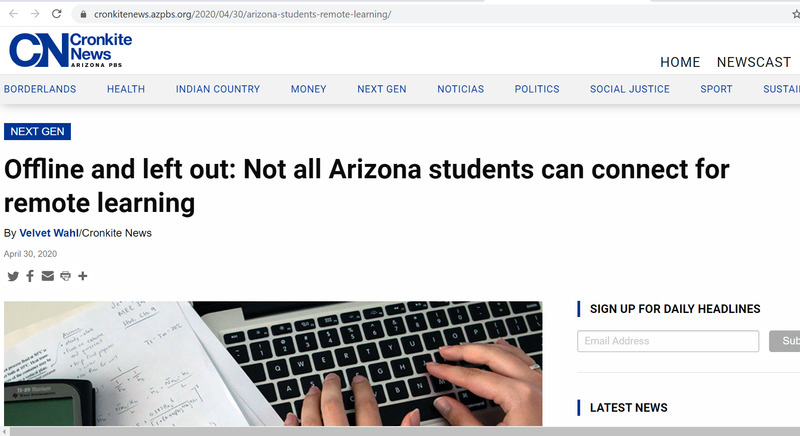
2020-04-30
This article focuses specifically on Arizona's efforts to provide students with internet/technology access in order to achieve online learning. It goes into detail about how several Phoenix schools dealt with the pandemic and online learning in the spring semester of 2020 as well as discusses how some students dealt with internet access issues in creative ways, either due to lack of internet or hotspot issues. Some examples are utilizing hotspots or through just going to public areas despite quarantine conditions to complete schoolwork.
-
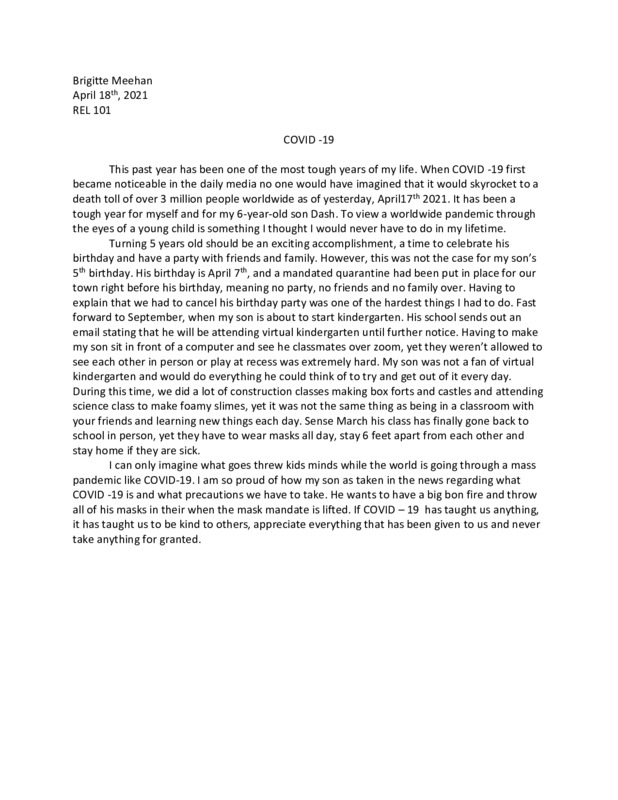
2021-04-18
what impact covid 19 has had on my son
-
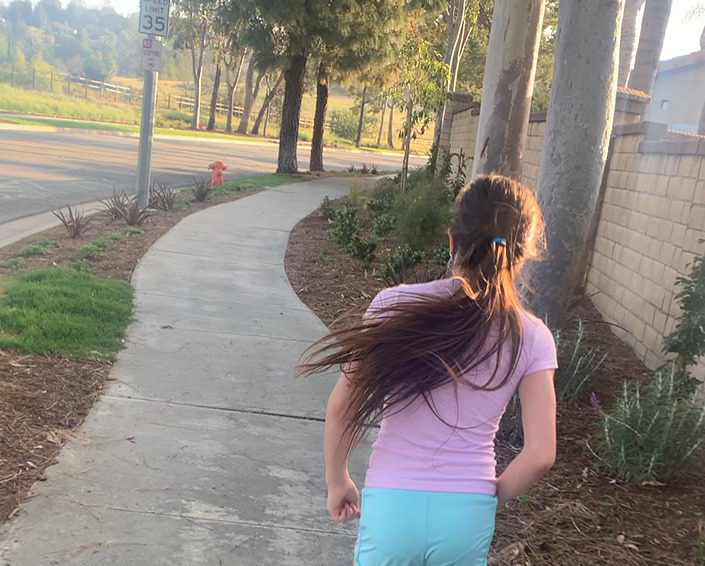
2021-04-14
My daughter has left our neighborhood less than five times in the past 13 months. I am not exaggerating. Now that the positivity rate in our area is 1.5%, we cautiously allowed my daughter to accompany me on a one mile run. You would have thought I’d taken her to Disney World. She was happier and more relaxed than she’s been in months. But she’s not a runner. She’s a competitive gymnast who hasn’t set foot in a gym in 13 months. She’s trained virtually with a gym in Northern CA and has worked out every single day. But we know it’s not the same. We also know that it’s time to create the team for the next season. It was time to contact her gym. We can keep promising she’s coming back but at what point is it just empty words? After a lot of prayer and internal debate, we texted her coach and said it’s time for her to come back. As you can see, she was initially scared at the idea, but that was quickly replaced by excitement when she found out she is really going back. But I have a pit in my stomach. Is it safe? Her coach isn’t vaccinated. Will my daughter be one of the children who contract it and have dire consequences? Or will her brother if she brings it home? How long can you keep a kid in a bubble? She already missed an entire season. Her mental health is so important, we know going back is going to be so amazing for that. But I am still so worried about the physical. One thing that this year has shown me is that I am an adult. I mean, obviously, I’ve been an adult for 22 years. But this year - protecting not only the safety of my children but my over 65 mom and in-laws. Advocating for the health of my students over politics. It’s like the pandemic has forced me to see that I can’t look to anyone to make adult decisions, it’s me. I’m the decision maker and these decisions can be life and death. I’m the adult. COVID has stripped that security we all had (probably foolishly). I don’t think I’ll ever feel safe again the way I did before this all began. So fingers crossed that my daughter’s journey back into competitive gymnastics is one that we can make safely.
-
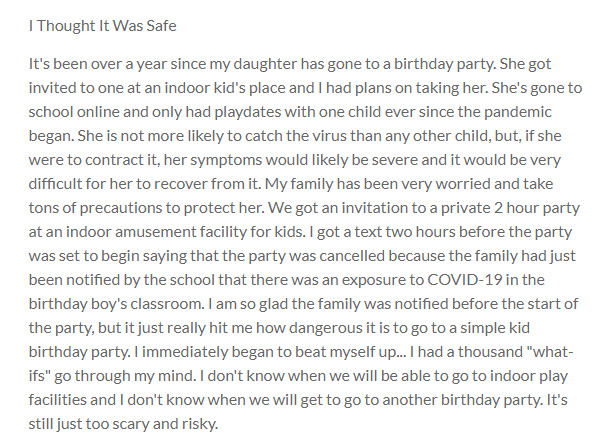
2021-04-14
It's been over a year since my daughter has gone to a birthday party. She got invited to one at an indoor kid's place and I had plans on taking her. She's gone to school online and only had playdates with one child ever since the pandemic began. She is not more likely to catch the virus than any other child, but, if she were to contract it, her symptoms would likely be severe and it would be very difficult for her to recover from it. My family has been very worried and take tons of precautions to protect her. We got an invitation to a private 2 hour party at an indoor amusement facility for kids. I got a text two hours before the party was set to begin saying that the party was cancelled because the family had just been notified by the school that there was an exposure to COVID-19 in the birthday boy's classroom. I am so glad the family was notified before the start of the party, but it just really hit me how dangerous it is to go to a simple kid birthday party. I immediately began to beat myself up... I had a thousand "what-ifs" go through my mind. I don't know when we will be able to go to indoor play facilities and I don't know when we will get to go to another birthday party. It's still just too scary and risky.
-
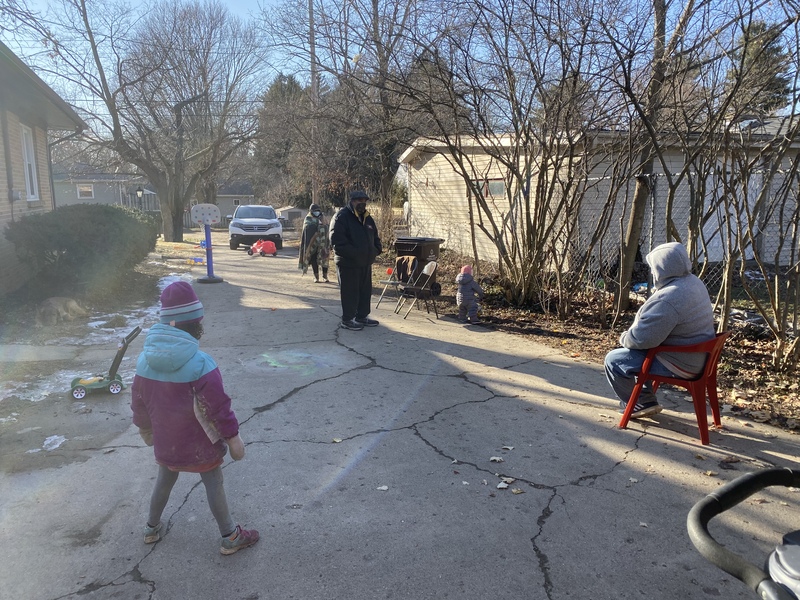
2021-03-06
Wanting to see the grandkids, my in-laws stopped by. They live about 45 minutes away. Everyone was outside, keeping about 6 ft apart with masks on while the kids played.
-
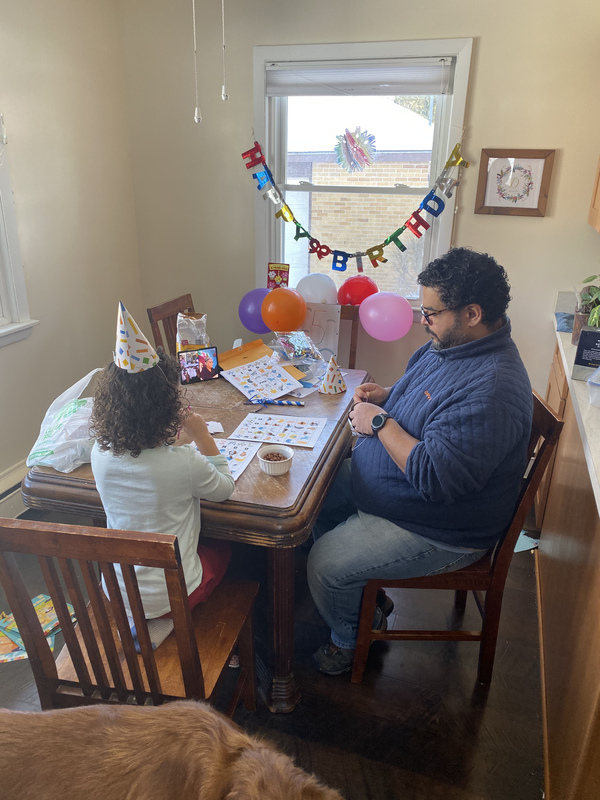
2021-02-19
My daughter turned five on February 19, 2021. We had no family or friends over to celebrate. We had individual Zoom calls with each set of grandparents & a Zoom birthday cake celebration with all of the aunts, uncle, cousins, a great aunt & grandparents late in the evening.
People sent their gifts ahead of time. She opened them throughout the day. We gave our daughter her birthday gifts, too.
This particular photo is showing virtual Bingo. One set of grandparents sent over a Bingo card set & they had a copy of the same one. We played the game virtually. My daughter had a lot of fun.
-
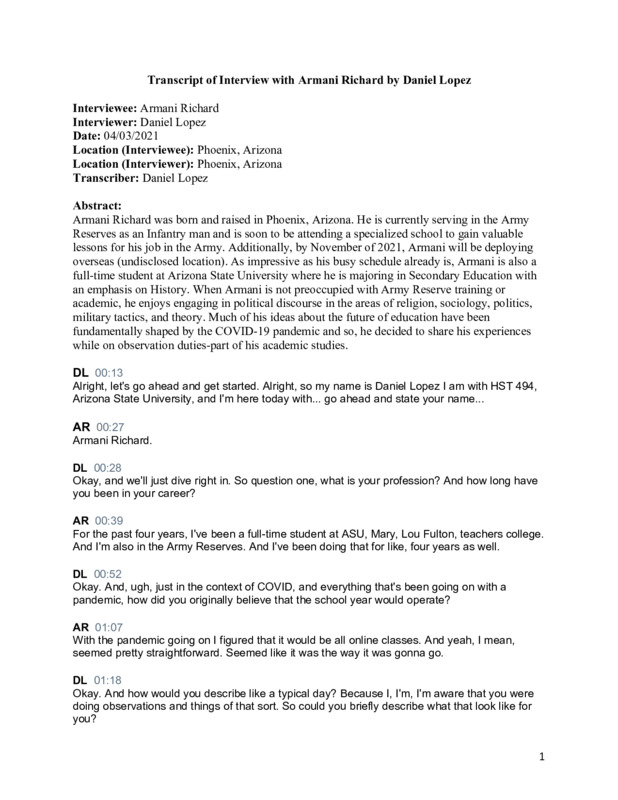
2021-04-03
Conversation with Armani Richard and the impact of COVID-19 on Arizona education. Currently studying at Mary Lou Fulton Teachers College and fulfilling a promising career in the Army.
-
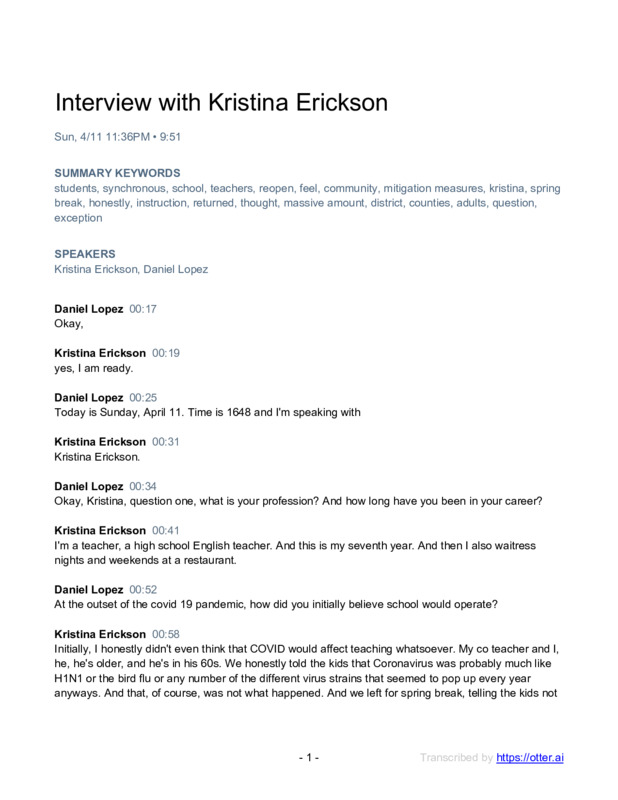
2021-04-11
Conversation with Kristina Erickson an Arizona K-12 educator. Ms. Erickson weigh-ins on the March 15th executive order, in-person instruction, COVID protocols and procedures, and the future of education in her community
-
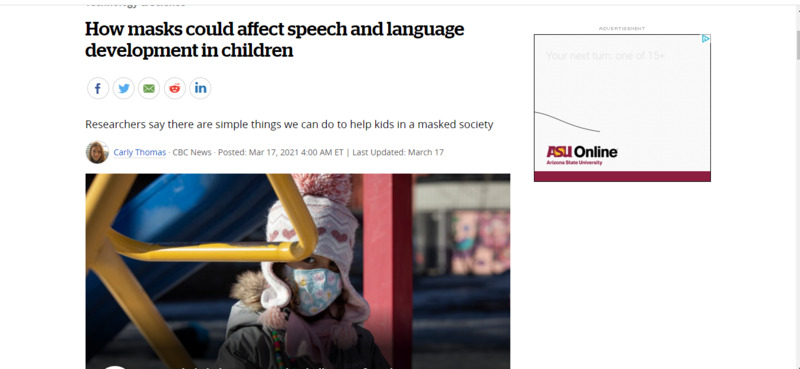
2021-03-17
There are socialization concerns among adults and adolescents, and most are aware of the reasons behind that. However, children still in early developmental stages (infants, toddlers) may struggle in the long-term.
The article primarily revolves around the words and expertise of senior scientist at Haskins Laboratories and a professor adjunct at the Yale Child Study Center, David Lewkowicz. There are physical, emotional, and mental struggles that could negatively impact early childhood development. Examples of these struggles are with how they learn languages by visual and auditory associations, which can be difficult with masks. Another related to masks is facial recognition.
Lewkowicz isn't filled with bad news, though. More time and direct attention given to face-to-face interactions and more explicit expressions of emotions can help compensate. These early years are when children are very adaptable as they take in the world around them, so there is hope for more perceptive children coming out of the pandemic rather than a decline.
-
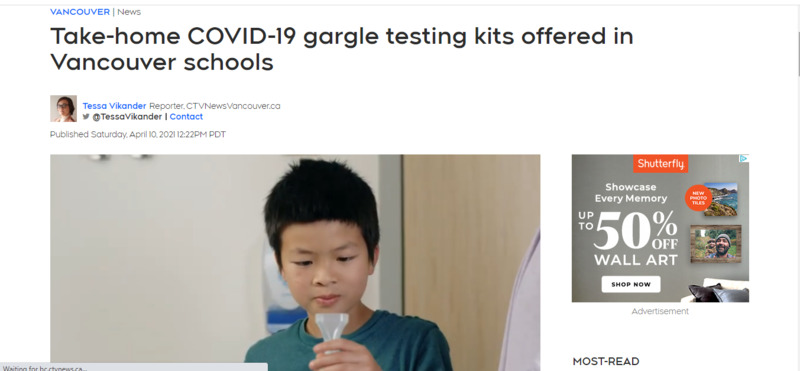
2021-04-10
In order to relieve some stress for COVID-19 testing, the BC Children's hospital in Vancouver, Canada is supplying 1,200 testing kits to 1,000 schools. It's supposed to be replenished as needed. However, the main purpose is to make testing more accessible (without medical facility visitations). Those who show symptoms, or simply get a runny nose, may be sent home.
-
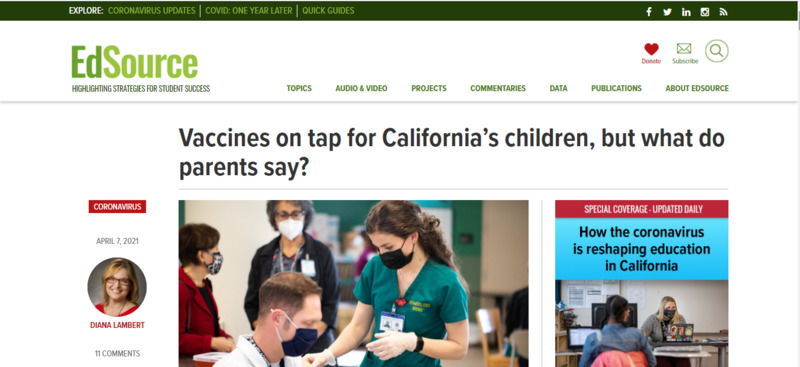
2021
California is soon expanding their vaccine eligibility to 16 and older on April 15, 2021. The plans for expanding it even more aren't expected to be for sometime. However, the announcement from Pfizer-BioNTech stating that the vaccine is safe and effective for 12 and older does give some hope for a quicker time frame.
The is a focus on giving children and adolescents back their youth. There are schools opening with hybrid instructions (online and on-site instruction), but there the on-site hours are always rotating students to minimize crowd interaction.
The article goes on to include opinions from parents of adolescents, which emphasized the importance of getting everyone (school faculty and students alike) vaccinated. Everyone seems eager to get back to pre-pandemic life as soon as possible, so the eligibility expansion does receive as good news and gives the public hope.
Naturally, however, it’s not all good news as people need to remain informed and cautious. The article reminds us that variants of the virus have the potential to harm younger children. Notably, it’s the B117 strain that’s been said by Dr. Michael Osterholm, director of the Center for Infectious Disease Research and Policy at the University of Minnesota, that can be “50% to 60% more contagious than other strains of Covid-19” from his observations of Minnesota schools.
-
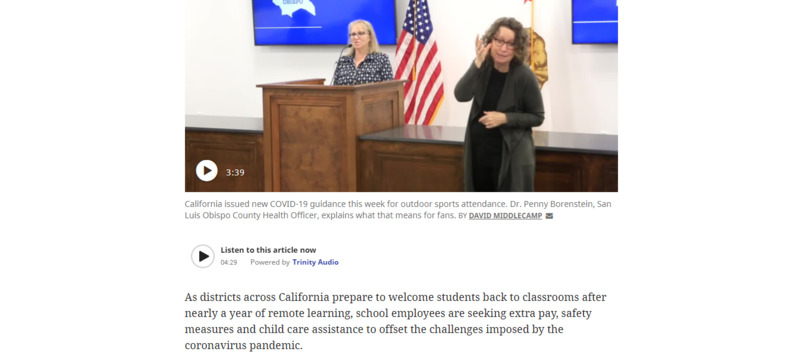
2021-04-10
Californian schools are opening back up, but there continue to be concerns over employees and their families. Although there have been some employees working at schools the past year (i.e. custodians), those working remotely (i.e. teachers) continue to face challenges in child care. Due to this, "Los Angeles Unified School District earlier this week announced it would provide a day care stipend of $500 a month for each child under age 5 to all full-time employees, including teachers."
The Service Employees International Union (SEIU 1021) did clarify within the article by Sacramento Bee that some demands could not be met. Among the demands was a one-time stipend amount of $1,500 for employees with children aged 3 - 14. This is an ongoing issue with its latest update on April 10, 2021 being: a weekly stipend of $125 for employees with children aged under 14.
This represents one of the issues employees of educational institutions are facing. They’re hesitant to return to in-person instruction. Although there’s a fair amount of news coverage of children returning to school, the ones hesitant (especially those responsible for the school to run smoothly) should also be acknowledged.
-
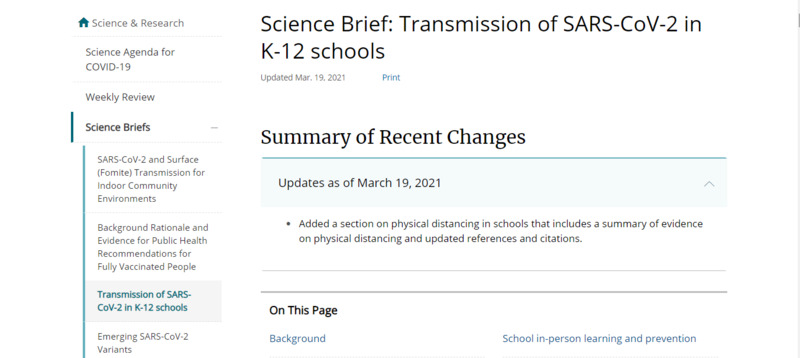
2021-04-10
(updated March 19, 2021) CDC report on scientific findings in terms of COVID-19, children, adolescents, and the unlikely transmission potential among these two groups (18 or younger). The experiences of other countries opening at various points during the pandemic contribute to the knowledge laid out in the report. One example of a recommended prevention strategy, physical distancing, is explained as a determining factor in preventing transmission. Yet, as the research shows, the prescribed 6-foot distance is less of a stress point when observing children and adolescents. In other words, several US studies have found low transmission rates when children are separated less than 6 feet. The same applies to children and adult interactions.
-
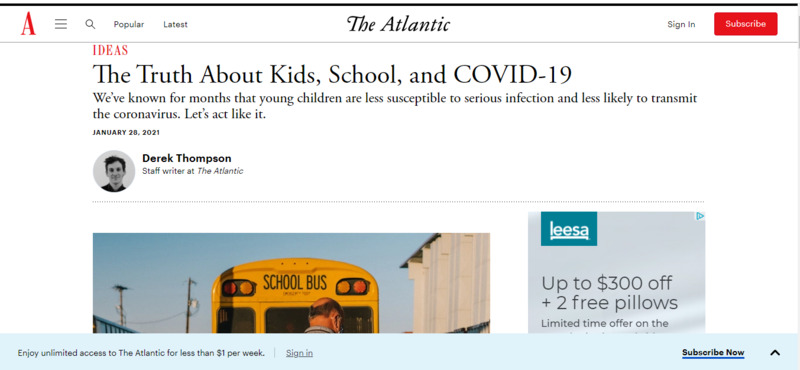
2021-04-10
This article, from The Atlantic, analyzes the Centers for Disease Control and Prevention (CDC) assertion that adequate ventilation, proper face coverings, and social distancing in schools will prevent transmission and a surge in COVID-19. The CDCs argument, which the author of the article fully supports, bases their support for in-person instruction on the "preponderance of available evidence," which includes both US studies and European. According to the CDC, people under 18, and young children especially, are less likely to infection and less likely to suffer severe symptoms. Moreover, one comprehensive plan to return children to the class includes access to vaccinations, high-quality scientific information, and strict COVID protocols.
-
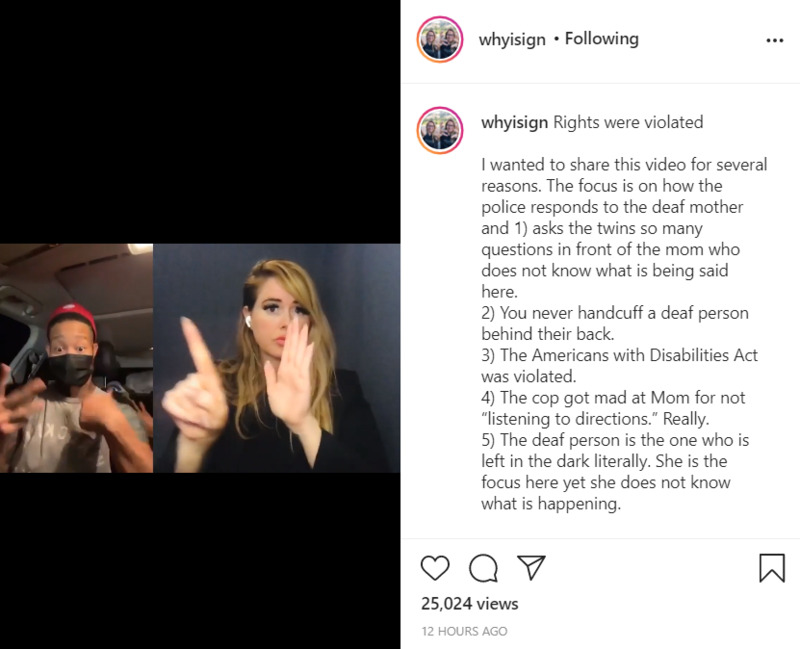
2021-04-09
Rights were violated
I wanted to share this video for several reasons. The focus is on how the police responds to the deaf mother and 1) asks the twins so many questions in front of the mom who does not know what is being said here.
2) You never handcuff a deaf person behind their back.
3) The Americans with Disabilities Act was violated.
4) The cop got mad at Mom for not “listening to directions.” Really.
5) The deaf person is the one who is left in the dark literally. She is the focus here yet she does not know what is happening.
Unfortunately, this is too common in deaf and hard of hearing people’s experience with the police. This should not be the common experience in dealing with the police.
There are more reasons, but the point is… this is one reason why the deaf people are so hesitant about getting help/support from the police. I hope this video as traumatizing, becomes a lesson. Police reform is much needed in so many areas, including learning how to communicate & how to work with deaf and hard of hearing people, the DO’s and the DON’Ts as seen here. I hope to see more training with the police departments in understanding how to work with deaf and hard of hearing people. I pray for healing for Mom- @burgundre Drizzy, and her twins. You can go and support her as she fights this.
Trigger warning here. Posted @withregram • @kelly4access 11 year old twin girls are forced by police (Michael Rose of the North Las Vegas PD) to interpret for their deaf mom and are interrogated while she is handcuffed. @burgundre recorded recorded her encounter on FB Live. Thanks so much @dpantv for working late in the night to make this accessible!! #asl #captions #signlanguage #police #discrimination #injustice #ada #policebrutality #whyisign #askmewhyisign
-

2021-04-08
This article titled "Coming of Age" is a great article that provides various art pieces from children all around the world. Who, through their art display the feelings they feel during the pandemic, certain stepping stones of their life that they were unable to celebrate fully, and even self-development that was limited. More can be said about the article by looking at the images provided and the unique descriptions below them.
-
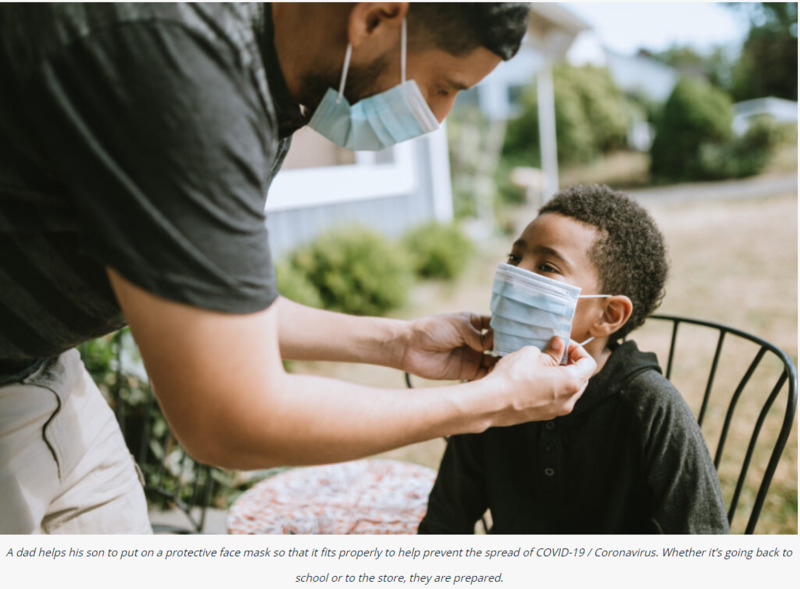
2021-04-08
This article speaks about obesity in children during the pandemic. With lots of parents work being closed as well as schools, parents struggle to provide healthy options to children and are stuck with buying cheaper option that is mostly filled with preservatives and high calories that is causing obesity rates to increase. Effects of diet during youth effects eating habits that a child developss as it grows. As weight plays a role mentally and physically in a person's health, the pandemic affects children in such away.
-

2021-04-08
This article speaks about birth rate spikes around the world during the pandemic. The chart provided shows birth increases. Many families are now welcoming children after 5-6 years. This is described as the next baby boom. The correlation this has with my research topic involves the idea that increased birthrates, and their effects on children at home along with the development of these children as they are born in the middle of the pandemic.
-
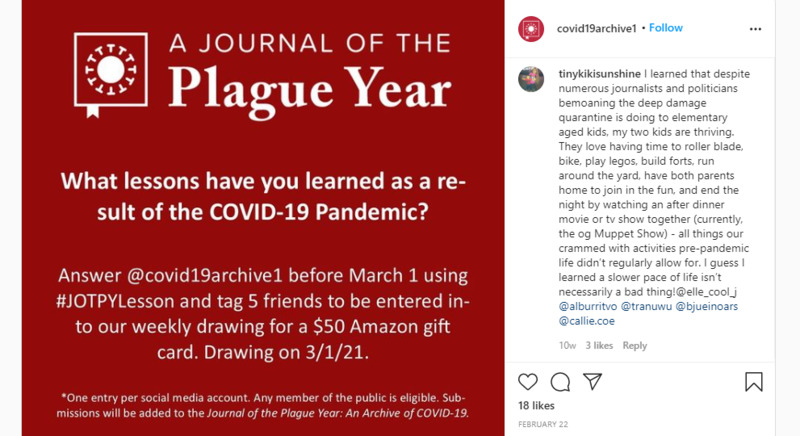
2021-02-22
I learned that despite numerous journalists and politicians bemoaning the deep damage quarantine is doing to elementary aged kids, my two kids are thriving. They love having time to roller blade, bike, play legos, build forts, run around the yard, have both parents home to join in the fun, and end the night by watching an after dinner movie or tv show together (currently, the og Muppet Show) - all things our crammed with activities pre-pandemic life didn’t regularly allow for. I guess I learned a slower pace of life isn’t necessarily a bad thing
-
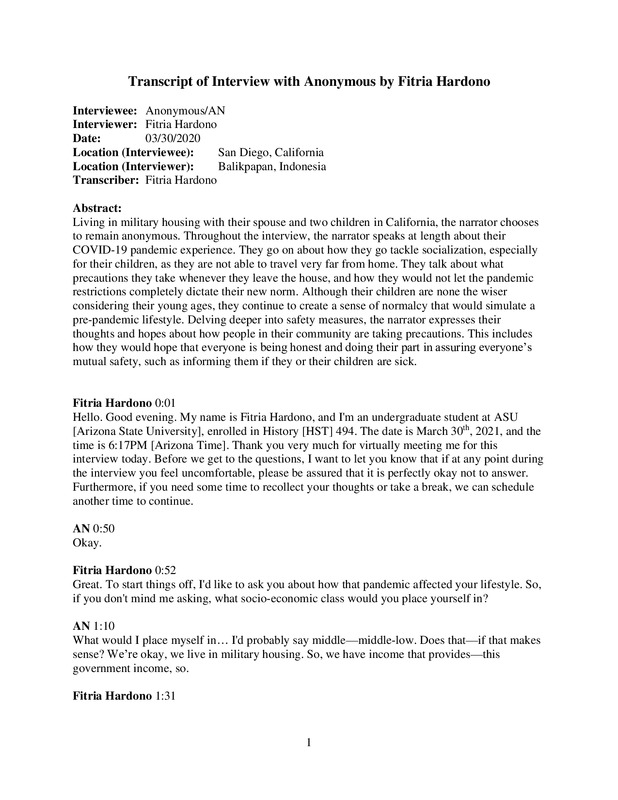
03/30/2021
Living in military housing with their spouse and two children in California, the narrator chooses to remain anonymous. Throughout the interview, the narrator speaks at length about their COVID-19 pandemic experience. They go on about how they go tackle socialization, especially for their children, as they are not able to travel very far from home. They talk about what precautions they take whenever they leave the house, and how they would not let the pandemic restrictions completely dictate their new norm. Although their children are none the wiser considering their young ages, they continue to create a sense of normalcy that would simulate a pre-pandemic lifestyle. Delving deeper into safety measures, the narrator expresses their thoughts and hopes about how people in their community are taking precautions. This includes how they would hope that everyone is being honest and doing their part in assuring everyone’s mutual safety, such as informing them if they or their children are sick.
-

03/30/2021
Alejandra Diaz lives in Tracy, California with her two children. Throughout the interview, social interaction was brought up frequently. It is a major factor that the COVID-19 pandemic had negatively impacted for herself and her children. As family is an important topic, Alejandra shares how their lifestyle used to be compared to how it was presently. Socialization is prevalent in her common interactions with family, friends, and in her children’s academic lives. As the questions shifts from lifestyle to academics, Alejandra talks about how her children’s education has been like during the pandemic, and about schools reopening in California. Alejandra has good things to say about the teachers as they would help where they could. Even before her children returned, she expresses her support towards in-person schools starting back up. She feels that this is necessary, under the right safety measures, for her children to learn and develop as it can prove difficult in isolation.
-
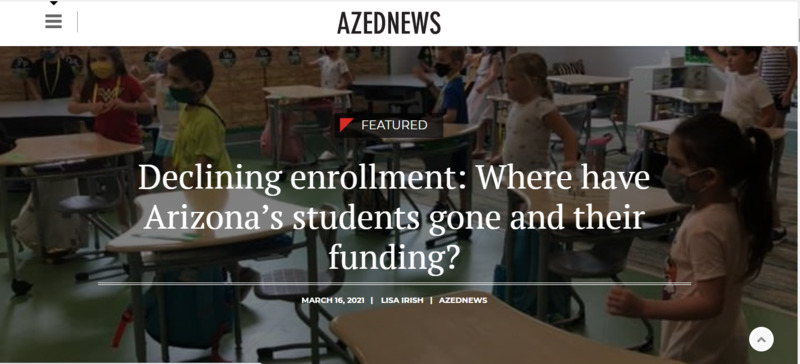
2021-03-16
This article highlights the declining enrollments of students in Arizona and their absence, so too does the funding disappear. According to the featured article, the combination of an approximate loss of 10% percent of the student population coupled with a drastic cut in the funding levels has significantly impacted the financial operations and organization of public school districts. The enrollment loss is mostly concentrated on the elementary levels, yet a notable loss of enrollment in high schools is of some concern. Declining enrollment not only affects the students' ability to develop important critical thinking and life skills, but in-person instruction should aid the student in recognizing the workload that comes with advanced degrees and education. Another option offers students the ability to learn through the hybrid instructional model.
-

2020-10-07
When a 2nd grade teacher at Parkland Elementary in Texas lost internet and left of her virtual classroom, her students realized the conversation was being recorded and won’t stop talking about toast.
-
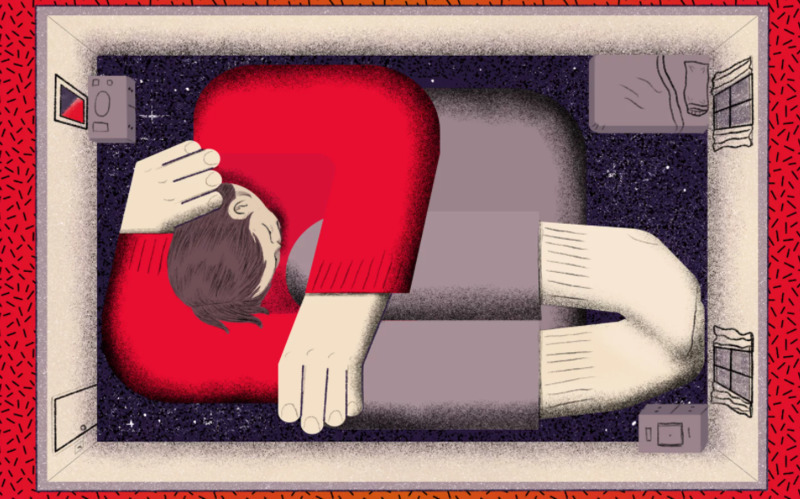
2021-03-31
This link is a podcast with which talks about a specific family of 4, including 2 girls ages 5 and 7 and the two guardians who have health witnessed changes in their children's behavior due to covid. It is a very interesting read and listen as both the children now have been hearing things about deaths due to covid and because of that say things such as "I don't care if I die". The read goes on to state some factual information, some important things said include, " a sex-abuse hotline operated by the Rape, Abuse & Incest National Network reported that half its calls in March came from minors, for the first time in its history." This was somthing that I heard for the first time and was shaken. Not only are children going through the stress of their own during the pandemic but they stay home and are potentially being abused. For some children going to school was an escape. I was though was very happy that these minors had information on who to contact for help.
-

2021-03-31
This link talks about the effects the pandemic has on children's nutritional health and physical activity. With parents already being stressed about managing through the pandemic, the quality of care for children had gone down. According to this site "Families report that during COVID-19 mitigation, time spent in physical activity and sports has decreased while sleep time and screen time have increased." It is understandable that this is an issue as children are limited from going outside as families fear for their health along with the lack of social life has caused children to sleep and use electronics more as a sense of coping from boredom. Not only is this affecting children now but will affect the future of these children as these will become habits, and habits are something that is hard to grow out of when they are developed since childhood.
-
2021-03-30
I hope I will be able to attend virtual school.
I hope I can visit my friends.
I hope my friends can visit me.
I hope we can eat at restaurants.
I hope the olympics will happen soon.
I hope I can travel all over the world again.
I hope we can go to amusement parks.
I hope I can make new friends.
I hope I don’t get lost on campus.
-
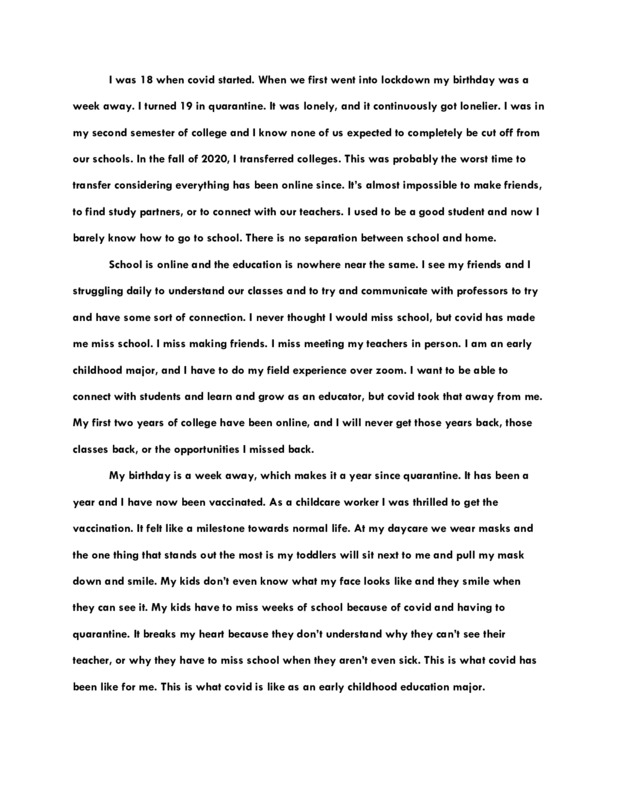
2020-04-02
I wrote about my story through covid. I am a college student studying Early childhood education. I am also a child care worker. My submission is about what it was like going through college during covid. This is important to me because it's my experience and I know many other college students feel the same way.
-

2021-03-17
By Jacob Holter/Cronkite News
WASHINGTON D.C. – Children from 6 months up to 12 years old could soon start getting the COVID-19 vaccine in Phoenix as part of a trial of the drug’s effectiveness on young people.
Drug-maker Moderna announced this week that Phoenix will be one of the cities where it will test smaller doses of its COVID-19 vaccine, which has currently only been approved for adult use, on preteens. The company has already started trials of the vaccine on teenagers.
While children have proven to be less susceptible to the disease, health experts say it’s important to have the option of a vaccine for younger kids as schools reopen and to improve the odds of “herd immunity” for the overall population.
“The reason we want to make sure that all of these kids get vaccinated is so we can truly achieve herd immunity. We don’t want to have little pockets of people who might be infectious and not be protected,” said Dr. Georges C. Benjamin, director of the American Public Health Association.
The preteen trials were announced Tuesday by Moderna, one of three pharmaceutical companies with vaccines approved for emergency use in adults in the U.S., along with Pfizer-BioNTech and Johnson & Johnson. Moderna and Pfizer vaccines require two doses, while the newer Johnson & Johnson vaccine has a one-dose protocol.
The announcement came the same day that the Arizona Department of Health Services announced that just over 1 million Arizonans have been fully vaccinated against the coronavirus. Overall, the state has administered about 2.6 million doses to a little more than 1.6 million people.
Moderna CEO Stéphane Bancel said in a statement that more than 53 million doses of his company’s version of the vaccine have been administered in the U.S., but “this pediatric study will help us assess the potential safety and immunogenicity of our COVID-19 vaccine candidate in this important younger age population.” The statement said the new trials would take place in the U.S. and Canada.
Dr. Steven Plimpton, the lead investigator for the Phoenix trial, said Tuesday that his office has “already gotten hundreds of calls” from parents interested in getting their children into the trial. He said parents interested in the trial in Phoenix can go to the KidCOVE site for more information or can call 602-368-1928 or 866-913-5454.
One University of Arizona expert said it will likely take a little while to get the trials in motion.
“I would say sometime in the next several weeks, as they get recruitment on board and they have a critical mass to start with and they have all of the aspects of the trial set up in terms of location, staffing, and everything that they need in place,” said Dr. Shad Marvasti, director of public health and prevention at the University of Arizona College of Medicine.
Moderna said that children in the first phase of the trial will receive doses of 25, 50, or 100 micrograms of the vaccine – an adult dose is 100 – depending on their age. Results from that phase will be used to determine dosages in a second phase when come subjects will get a placebo.
ad1
Ultimately, Moderna expects to include 6,750 children in the latest trials.
“The adult dose for the Moderna is 100 micrograms, but they are starting with 25 micrograms and then basically watching folks and kids to see how they react,” Marvasti said. “If that looks good and there are no major issues, then they will have a group of kids in the study with 50 micrograms and then if that looks okay they will have another group that has 100 micrograms.”
He added that Moderna’s trust that the vaccine is safe enough to begin trials on kids could have the added benefit of helping to quell vaccine hesitancy among others.
“Hopefully, depending on the results, it will help give people more confidence to get the vaccine, especially if it proves to be as safe and effective in children as it has been in adults,” Marvasti said.
The announcement of the preteen trials also comes as the state has ordered schools to begin to resume in-person schooling, after a year in which most students have attended class virtually.
Benjamin said that with schools reopening, in Arizona and across the U.S., a vaccine for youth would make a definite difference in controlling the virus, as it would prevent kids from spreading it to each other and then bringing it home with them. Vaccination would also expedite kids’ ability to return to normal.
“Getting kids vaccinated, I think, will certainly improve their quality of life and their ability to effectively interact with their friends,” he said.
-
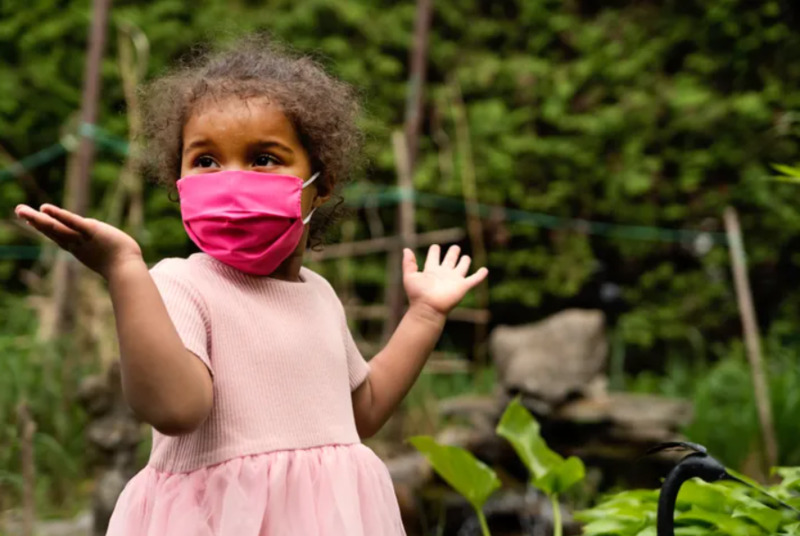
2021-02-03
This link discusses if experts are really worried about if the development of toddlers is important or are there bigger issues. A fact stated in this text says " that 60% of teenagers say they’re lonely to deeply troubling federal data that revealed a 24% jump in mental health-related emergency room visits among 5- to 11-year-olds." This is a very concerning matter as children as young as 5-11 should be living a healthy life mentally and physically as those are the prime time of their growth and development. It goes on to talk about how these prime timed years of a child's life affect how he is as an adult. Certain aspects that small roles in a child's life may unknowingly affect it as it grows.
-

2021-01-11
This link provided discusses the lack of social development that is being portrayed in toddlers as most of them have fewer interactions with people other than their intermediate family and friends. Much of the time when they do see others, they are in masks which makes it difficult for them to understand emotion and detect feelings. The mother in the article discusses that she does not know if it's her introverted genes that have been passed on to the child or if it's just the lack of social development the toddler has.
-
2021-03-26
Dear post-covid world,
I dream for people to take science more seriously.
I dream for school to realize the pain it gives some people.
I dream that the “rulers” of the school have learned that they aren’t better than others.
I dream that the teaching of racism dies.
I dream that women get equal pay.
I dream that people can learn to love mother nature.
I dream that people will smile more.
I dream that adults would stop acting like babies.
I dream that we can trust one another again.
I dream that I can go back to the childhood I used to know.
The childhood that didn’t care about a thing in the world.
The childhood that didn’t have to see and learn the cruelty of the real world.
I dream that at least one person reads my letter.
I dream that all of this will come true.
I know it won’t.
But a kid can only dream.
Sincerely,
One voice
-
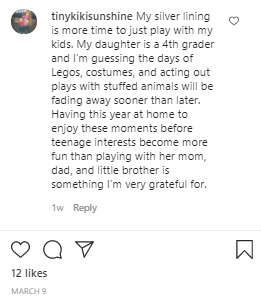
2021-03-14
My silver lining is more time to just play with my kids. My daughter is a 4th grader and I’m guessing the days of Legos, costumes, and acting out plays with stuffed animals will be fading away sooner than later. Having this year at home to enjoy these moments before teenage interests become more fun than playing with her mom, dad, and little brother is something I’m very grateful for.
-

2021-03-23
No existing COVID-19 vaccine is approved for anyone under the age of 16. The companies responsible for the vaccines are working on getting another vaccine approved for children and have begun trial phases. Some Arizona parents have enrolled their children in the trials, not only so their children can get vaccinate, but also as a way to help the community.
-

2021-02-12
On February 12, 2021, the Centers for Disease Control and Prevention (CDC) issued guidance on COVID-19 as it relates to the "re-opening" of schools for in-person instruction. From the office of Governor Doug Ducey, Executive Order 2021-04 provides instruction for the Arizona Department of Education to follow in each district in the state of Arizona.
-
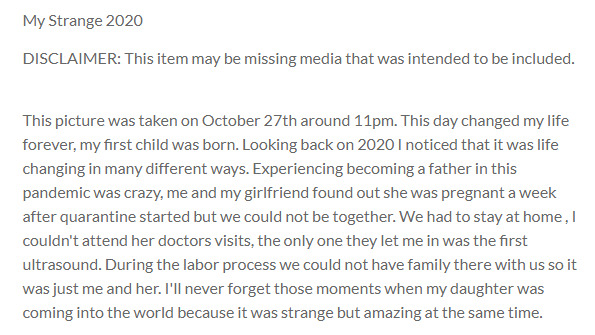
2020-03-23
This picture was taken on October 27th around 11pm. This day changed my life forever, my first child was born. Looking back on 2020 I noticed that it was life changing in many different ways. Experiencing becoming a father in this pandemic was crazy, me and my girlfriend found out she was pregnant a week after quarantine started but we could not be together. We had to stay at home , I couldn't attend her doctors visits, the only one they let me in was the first ultrasound. During the labor process we could not have family there with us so it was just me and her. I'll never forget those moments when my daughter was coming into the world because it was strange but amazing at the same time.
-
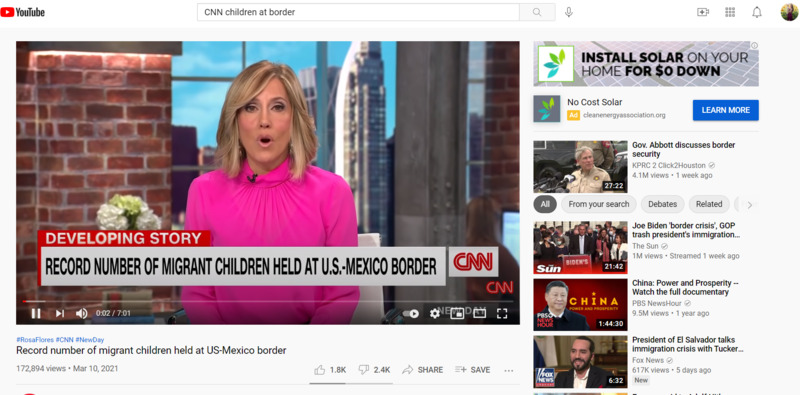
2021-03-10
The number of unaccompanied migrant children in US Border Patrol facilities, which are akin to jail cells and not intended for kids, has reached dramatic highs, according to internal agency documents reviewed by CNN, underscoring the urgent challenge facing the Biden administration.
More than 3,200 unaccompanied migrant children were in Customs and Border Protection custody, according to the documents dated Monday. Of those, around 2,600 were awaiting placement in shelters suitable for minors, but there were just over 500 beds available to accommodate them.
The latest data comes on the heels of a trip to the US-Mexico border by senior administration officials to assess the situation on the ground amid an increasing number of arrests and indicates a rapidly increasing trend of unaccompanied children coming into the US. Less than a week ago, there were around 1,700 children in Border Patrol custody.
-
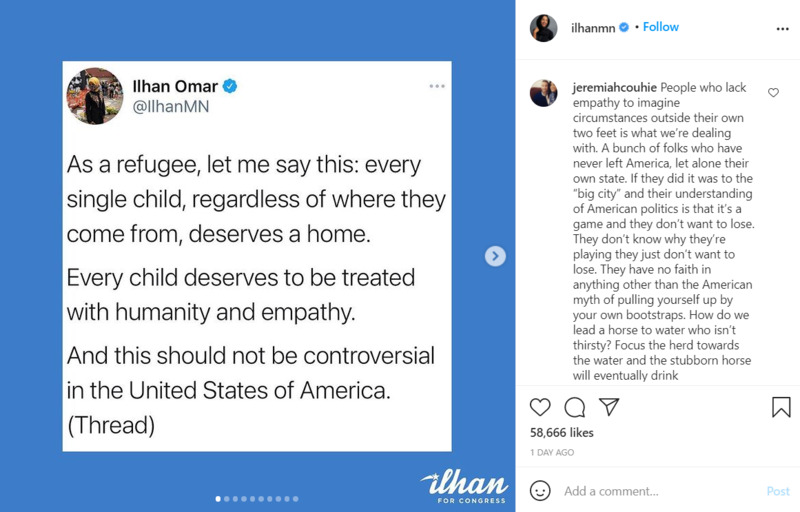
2021-03-21
People who lack empathy to imagine circumstances outside their own two feet is what we’re dealing with. A bunch of folks who have never left America, let alone their own state. If they did it was to the “big city” and their understanding of American politics is that it’s a game and they don’t want to lose. They don’t know why they’re playing they just don’t want to lose. They have no faith in anything other than the American myth of pulling yourself up by your own bootstraps. How do we lead a horse to water who isn’t thirsty? Focus the herd towards the water and the stubborn horse will eventually drink
-
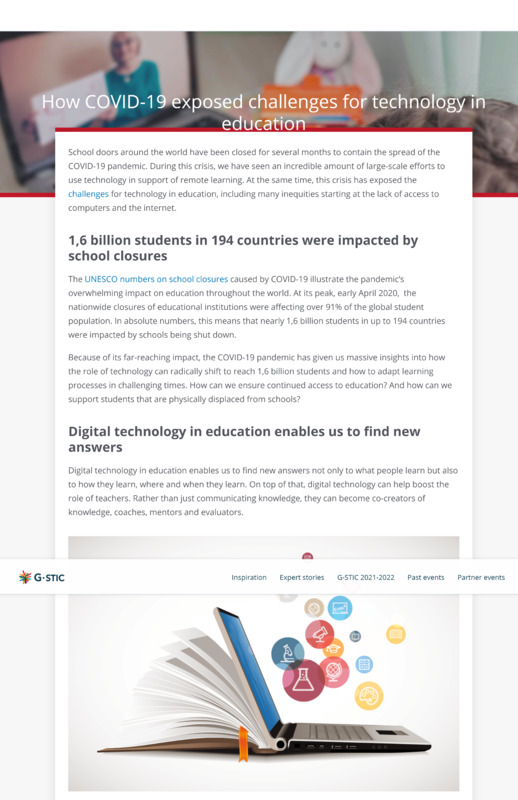
2020-06-01
The article addresses how challenges in access/use of technology by students and teachers have been highlighted due to the pandemic
-
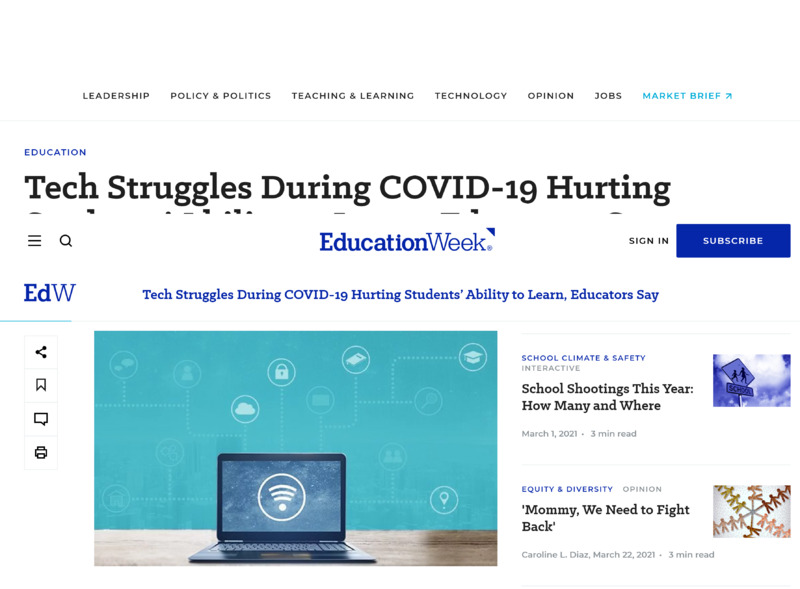
2020-09-24
This article comes from the perspective of educators who struggled with teaching students remotely, and includes statistics referring to students who had technology/situational issues that affected their work.
-
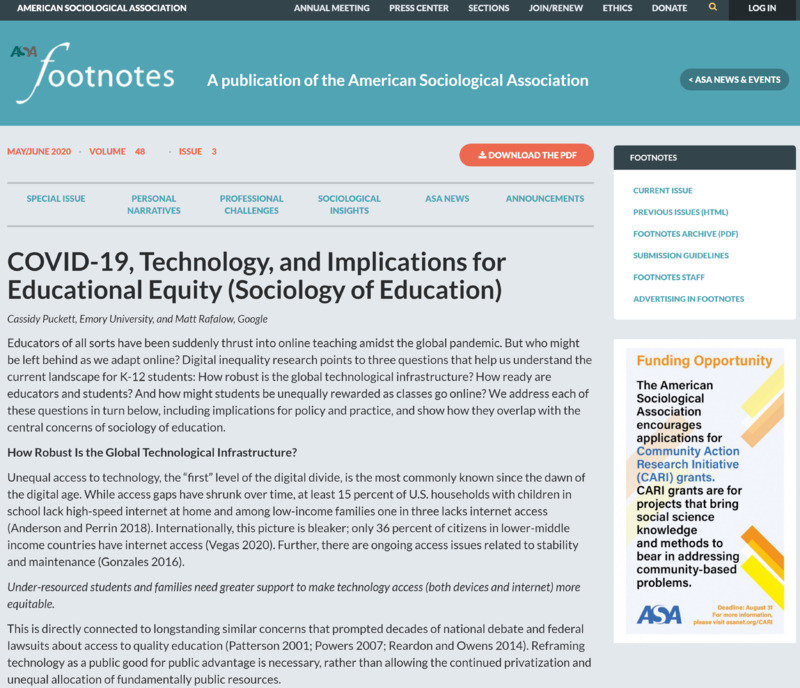
2020-05-19
This article addresses the divide between students who had easy access to technology/digital skills during the pandemic, and how it came into play in regards to grades
-
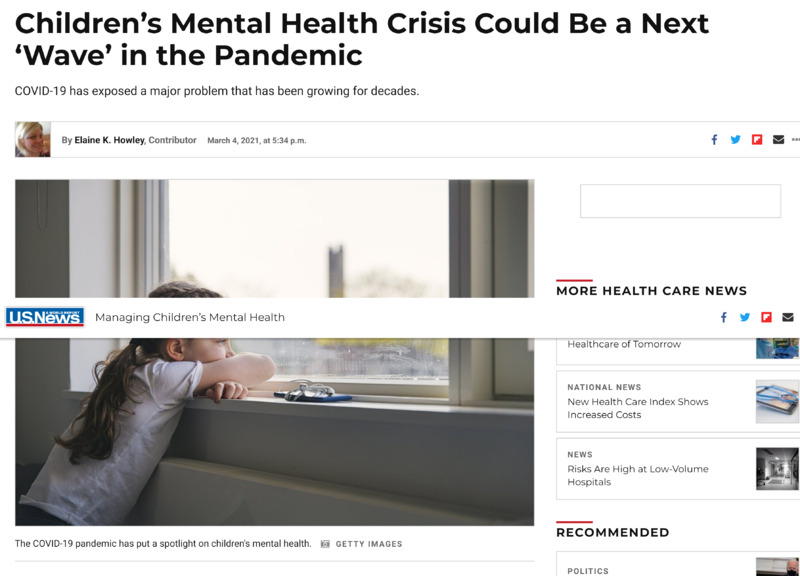
2021-03-21
This link provided showcases the severity of the pandemic's effect on children's mental health and it becoming the next "wave" in the pandemic
-
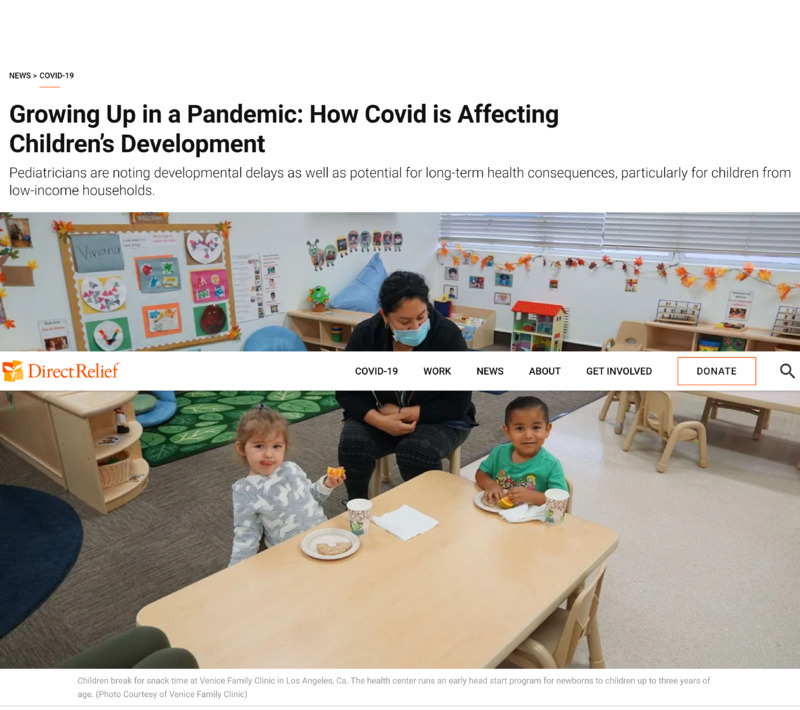
2021-01-19
This link provided explains how the pandemic is affecting the development of children.
-

2021-03-21
This is an article that provides an inside on taking care of a newborn during the pandemic.
-
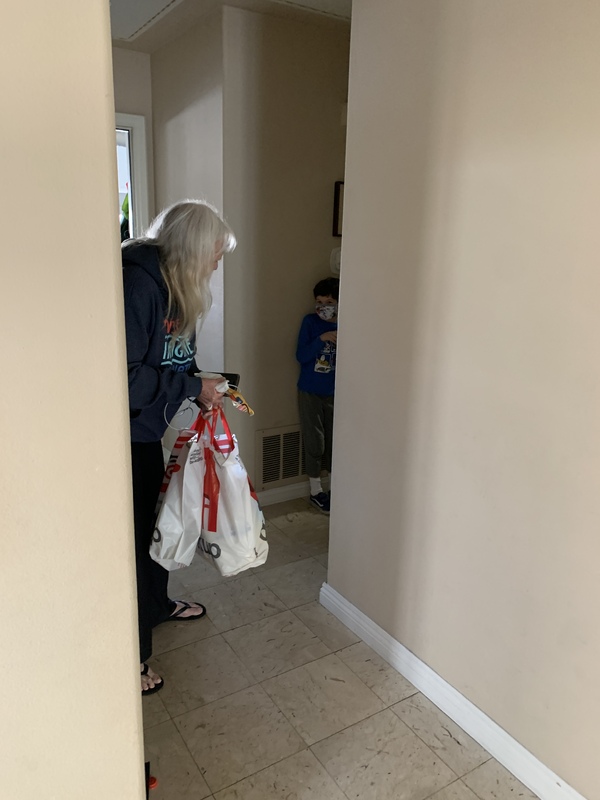
2021-03-21
For the past year, my husband has been the only one to do errands to keep the risk low. Anytime he went out, he showered and put his clothes in the laundry. No one has stepped foot inside our house in over a year. It may see extreme, but more than once during COVID, Southern CA was the country’s hotspot. We have been extremely cautious, and with both the death rates and people within our own circle who weren’t cautious getting infected during the winter spike,
I do not regret our decision. Now numbers are thankfully declining and, even more significant, my mom (who lives with us) has received both doses of the vaccine and my husband and I should receive our second doses next week. Slowly, our lives will hopefully be able to open up a bit. But the moment captured here reminds me that the shift may not be as easy for our kids. My son, who hasn’t had a play date or left this street in months, flattened himself against the wall and refused to move when my mom came back from a Target curbside pick up. She didn’t even get out of the car but my son was terrified that she’d give him COVID. It’s going to be a long process to make them feel safe again.
 2021-04-22
2021-04-22 2021-04-19
2021-04-19 2021-04-21
2021-04-21 2021-04-05
2021-04-05 2021-04-20
2021-04-20 2021-04-20
2021-04-20 2020-04-30
2020-04-30 2021-04-18
2021-04-18 2021-04-14
2021-04-14 2021-04-14
2021-04-14 2021-03-06
2021-03-06 2021-02-19
2021-02-19 2021-04-03
2021-04-03 2021-04-11
2021-04-11 2021-03-17
2021-03-17 2021-04-10
2021-04-10 2021
2021 2021-04-10
2021-04-10 2021-04-10
2021-04-10 2021-04-10
2021-04-10 2021-04-09
2021-04-09 2021-04-08
2021-04-08 2021-04-08
2021-04-08 2021-04-08
2021-04-08 2021-02-22
2021-02-22 03/30/2021
03/30/2021 03/30/2021
03/30/2021 2021-03-16
2021-03-16 2020-10-07
2020-10-07 2021-03-31
2021-03-31 2021-03-31
2021-03-31 2020-04-02
2020-04-02 2021-03-17
2021-03-17 2021-02-03
2021-02-03 2021-01-11
2021-01-11 2021-03-14
2021-03-14 2021-03-23
2021-03-23 2021-02-12
2021-02-12 2020-03-23
2020-03-23 2021-03-10
2021-03-10 2021-03-21
2021-03-21 2020-06-01
2020-06-01 2020-09-24
2020-09-24 2020-05-19
2020-05-19 2021-03-21
2021-03-21 2021-01-19
2021-01-19 2021-03-21
2021-03-21 2021-03-21
2021-03-21